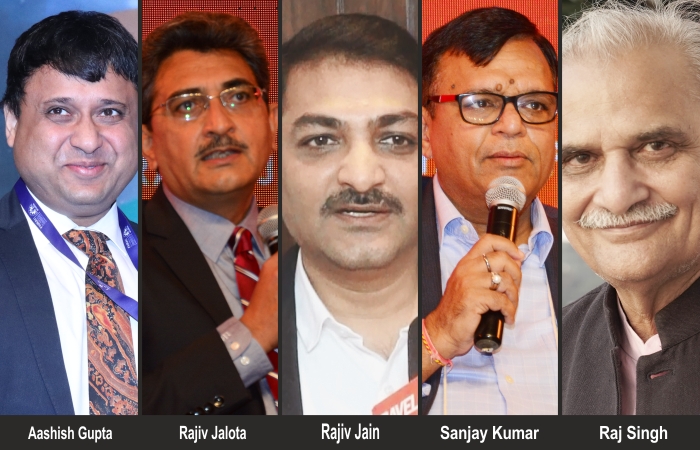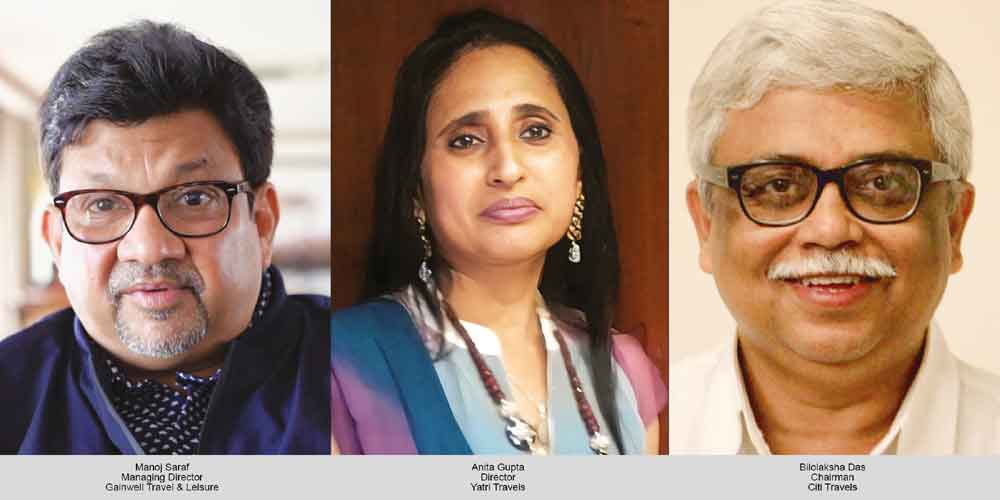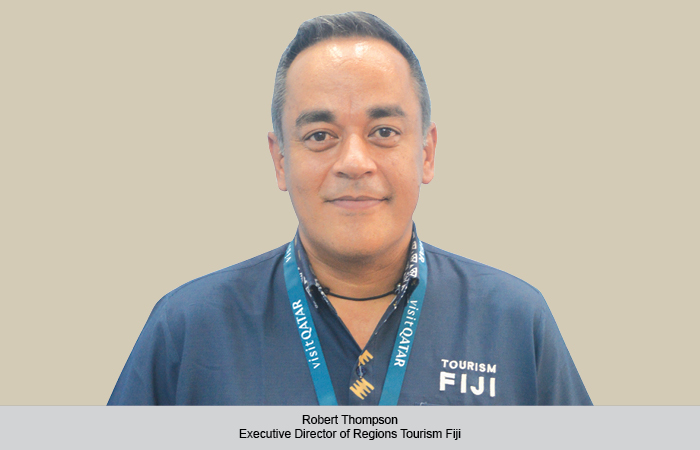Connectivity plays an important role in boosting tourism. As transportation services in India, whether it is rails or roads, are improving, the only thing needed for all stakeholders is to join hands to benefit each other and work towards offering best facilities for tourists.
Nisha Verma
One of the sessions, titled ‘Connectivity: New Frontiers’, at the 36th IATO Annual Convention saw how transportation is pushing the tourism sector in India to reach new heights. Aashish Gupta, Consulting CEO, FAITH, was the moderator and the panellists included Rajiv Jalota, Chairman, Mumbai Port Trust, Rajiv Jain, Additional General Manager (Tourism), Indian Railway Catering & Tourism Corporation (IRCTC), Sanjay Kumar, Chief Strategy & Revenue Officer, IndiGo and Raj Singh, Chairman, Antara Luxury River Cruises.
Gupta said that tourism is dependent on transportation and the goal of the conversation was to determine which IATO member could work best on each vertical of transportation so as to revive his or her business.
Cruising status
Starting with cruises, Gupta asked about the status of the cruise industry currently, which could be a huge opportunity for India with its 700-km coastline.
Jalota shared that cruise tourism was on an upward trend before COVID-19 and that 2019-20 was the peak year for cruise tourism in India. “There were 4.67 lakh cruise passengers on 451 cruise calls, which was way beyond the 2.2 lakh passengers predicted in 2019-20 by a study. This included two international cruise calls as well. While the market is reviving internationally, India has not seen much growth. However, one domestic cruise has started in Mumbai in September this year, which goes to Goa, Diu, Kochi and Lakshadweep. As of now, 40 cruise calls with 80,000 passengers were reported.”
He believes that cruising has a bright future because the country has formulated the master plan for cruise tourism, which is divided into three parts — ocean cruising, river cruising, and island and lighthouse tourism. By 2042-43, a growth of 10 to 12 times with 40 lakh cruise passengers is forecast, out of which over 20 lakh will be domestic cruise passengers. Domestic cruises have a potential, from an infrastructure point of view. It would need smaller vessels and less infrastructural availability. For both international and domestic cruises, the Ministry of Ports, Shipping and Waterways (MoPSW), in collaboration with MOT, has focused on developing six ports as cruise destinations — Mumbai, Goa, Mangalore, Kochi, Chennai and Visakhapatnam,” he informed.
Boost to aviation
Giving an overall view of the aviation industry, Kumar shared that while ongoing COVID-19 impacted the aviation sector, the industry had recovered 70 per cent of the pre-COVID-19 levels before the second wave, which saw numbers dip to 10 per cent of the pre-pandemic levels and eventually go back to almost 2019-20 levels by 2021-end. “Despite Omicron, we are still continuing to operate almost at pre-pandemic levels. We have seen changing patterns in the marketplace over the last two years. With metro traffic being largely dependent on corporates, we have seen growth in the new markets, i.e., tier 2 and tier 3 cities. In the last three to four months, we have seen cities such as Kanpur, Bareilly and Gwalior doing well, and we made progress by deploying our capacity there. A lot of domestic growth is visible despite the postponement of international flights,” he said.
Kumar claimed that India continues to be an underpenetrated market. “We believe that we need more than 2,000 flights in the next 10 years. The IATO members can take huge advantage of the network growth coming out of the domestic market. There is a need to look at products around domestic travel, which would meet our business objectives together,” he asserted.
Not just railways
IRCTC is coming up with many innovative products and has come a long way by changing its perception as a tourism company, instead of being a platform to book train tickets. Jain revealed, “The IRCTC has gone into every area of tourism, be it cruises, airlines, railways, or land traffic. However, 30 to 35 per cent of our tourism revenue still comes from rail products. On a retail basis, we have some tie-ups and back-up quotas where confirmed tickets are available for those booking a tourist package. Airline traffic has grown, 38 to 40 per cent of our traffic comes from domestic air packages. We have tied up with Antara Luxury Cruises as well as other ports in Mumbai. We are facilitating tourism by all modes of transport instead of just railways.”
He stated that IRCTC was open to working with agents and agencies to sell packages and partner on a PPP model. “We have also entered the budget hotel segment. Apart from the Maharaja Express and the Buddhist Express, we have also launched the Ramayana Circuit for 17 days,” he added.
Inland cruising
Singh claimed that the potential of river cruising in India is immense, with over 110 rivers being designated as national waterways. “Many of these rivers are navigable, which means river cruise tourism can happen everywhere. The important thing is that the ships must be made to suit the river’s conditions. At Antara, we take domestic cruises to places such as the Sunderbans, colonial towns, and the like. Also, we will be operating cruises in Odisha for the first time as the government there is doing a lot. There are avenues for tour operators to book new cruises and destinations. We are also looking into combining river cruises with sea cruises. We have nine cruises and we can offer special rates and deals for the IATO members,” he offered.
Joining hands
While new and large vessels will be built, Jalota said, this would require facilities and eco-system development, which would start with capacity building or human resource development. Both MoPSW and MOT are pitching in with adequate funds under Sagarmala. “If the IATO could give more ideas regarding locations and the kind of investment needed, this sector could pick up pace. We need to work as partners, as this is the right time,”
he suggested.
Kumar shared that during the pandemic they saw opportunities in many verticals, including domestic charters. “We have seen people hiring Airbus 320 and 321 for groups ranging from 10 to 50 pax. I think it is a new niche market not only in the domestic sector, but also for nearby countries such as Singapore, the UAE and Maldives. Another segment for which we have developed connectivity is the religious tourism segment, and the IATO members should look at destinations such as Tirupati, Prayagraj (Allahabad), or Banaras, and make packages around them for foreign as well as domestic tourists. Also popular are domestic holiday charters, which are a great opportunity as well. We can think through a strategy to market and sell such packages together. There is huge potential in the Indian domestic tourism market.”
Affiliate marketing
Jain claimed that the IRCTC, which was an old PSU that started with a capital of ` 5 crore, today has a net worth of more than ` 1,400 crore in two decades.
“The IATO and its members can partner with us since we sell our packages not only via direct sales team or online, but we are open agency-oriented businesses too. Depending on the product, we charge a travel agency commission ranging from 2 to 7 per cent. It is a simple process and does not take much time. Within a week, an agent can come on board. Right from air package, rail package, or road package, we have provision for agency commission,” he said.
Stay informed
Singh advised that if the IATO members could talk to their overseas partners about river cruising of international standards being available in India, it could create the right buzz. “Once that is done, we can help you out with the kind of offerings we have. We will be glad to do a session with the IATO members to make them aware of the river cruise potential and the places where it is done,” he said.
Summing up, Gupta said, “We need to work together and only then can we look at a long-term vision different from online modelling, where the customers look for instant gratification. I believe that this is a period of hibernation and after this, the IATO members need to look at reskilling and upgradation to change their strategy, scale and scope with better partnerships and products.”
 TravTalk India Online Magazine
TravTalk India Online Magazine





